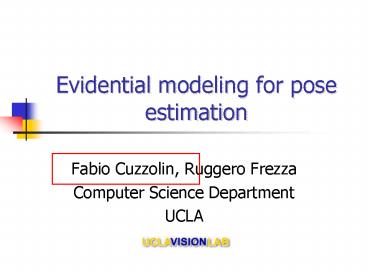Evidential modeling for pose estimation
Title:
Evidential modeling for pose estimation
Description:
action recognition and object tracking. metrics on the space of ... map between each region and the set of training poses qk with feature value yk inside it ... –
Number of Views:23
Avg rating:3.0/5.0
Title: Evidential modeling for pose estimation
1
Evidential modeling for pose estimation
- Fabio Cuzzolin, Ruggero Frezza
- Computer Science Department
- UCLA
2
Myself
- Masters thesis on gesture recognition
- at the University of Padova
- Ph.D. thesis on the theory of evidence
- Post-doc in Milan with the Image and Sound
Processing group - Post-doc at UCLA in the Vision Lab
3
My past work
- geometric approach to the theory of belief
functions - space of belief functions
- geometry of Dempsters rule
4
.. again ..
- algebra of compatible frames
- linear independence on lattices
- action recognition and object tracking
- metrics on the space of dynamical models
5
and todays talk
1
- the pose estimation problem
2
- model-free pose estimation
3
- evidential model
4
- experimental results
6
Pose estimation
- estimating the pose (internal configuration) of
a moving body from the available images
CAMERA
t0
tT
7
Model-based estimation
- if you have an a-priori model of the object ..
- .. you can exploit it to help (or drive) the
estimation
8
Model-free estimation
- if you do not have any information about the
body..
9
Collecting training data
- motion capture system
10
Training data
- when the object performs some significant
movements in front of the camera - a finite collection of configuration values are
provided by the motion capture system
q
q
1
T
y
y
1
T
- while a sequence of features is computed from
the image(s)
11
Learning feature-pose maps
- Hidden Markov models provide a way to build
- feature-pose maps from the training data
12
Evidential model
- approximate feature spaces ..
- .. and approximate parameter space ..
13
Estimation
14
Human body tracking
- two experiments, two views
15
Feature extraction
- three steps original image, color segmentation,
bounding box
16
Performances
- comparison of three models left view only, right
view only, both views
17
Estimation errors
- Euclidean distance between real and predicted
marker position
18
Visual estimate
19
Conclusions
- pose estimation of unknown objects is a difficult
task - a bottom-up model has to be built from the data
in a training session - the DS framework allows to formalize the idea of
feature-pose maps in a natural way through the
notion of compatible frames - Dempsters combination provides a method to
integrate features to increase robustness































